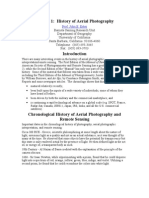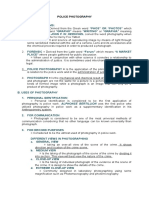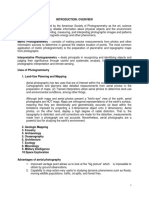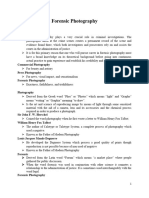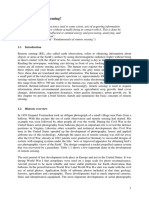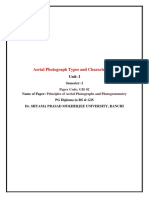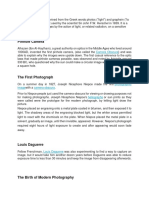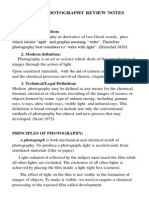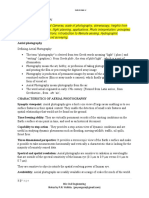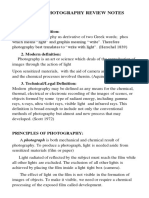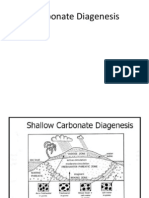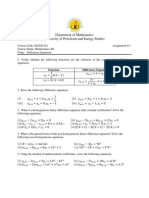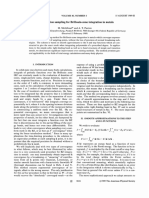Short Note On Aerial Photograph
Short Note On Aerial Photograph
Uploaded by
Arjit GidwaniCopyright:
Available Formats
Short Note On Aerial Photograph
Short Note On Aerial Photograph
Uploaded by
Arjit GidwaniOriginal Title
Copyright
Available Formats
Share this document
Did you find this document useful?
Is this content inappropriate?
Copyright:
Available Formats
Short Note On Aerial Photograph
Short Note On Aerial Photograph
Uploaded by
Arjit GidwaniCopyright:
Available Formats
Short Note on Aerial Photograph
Aerial photography is the taking of photographs of the ground from an elevated position. The term usually refers to images in which the camera is not supported by a ground-based structure. Cameras may be hand held or mounted, and photographs may be taken by a photographer, triggered remotely or triggered automatically. Platforms for aerial photography include fixed-wing aircraft, helicopters, balloons, blimps and dirigibles, rockets, kites, poles and parachutes. Aerial photography should not be confused with Air-to-Air Photography, when aircraft serve both as a photo platform and subject. It is useful for Remote Sensing. Classification: There are four types of Aerial Photographs. Such as: 1. 2. 3. 4. Normal/Panchromatic/Black & White (Lehmans) Color Black & White Infrared Color Infrared
Black & White:
Austin, Texas Color: In this technology color film is used to determine the imagery. Black & White Infrared: In 1903 or 1904 the first reliable black and white infrared film was developed in Germany. The film emulsion was adjusted slightly from regular film to be sensitive to wavelengths of energy just slightly longer than red light and just beyond the range of the human eye. By the 1930s, black and white IR films were being used for landform studies, and from 1930 to 1932 the National Geographic Society sponsored a series of IR photographs taken from hot air balloons.
Color Infrared:
Throughout the 1930s and 1940s, the military was hard at work developing color infrared film, eager to exploit it for surveillance. By the early 1940s the military was successful in its attempts. It developed a film that was able to distinguish camouflaged equipment from surrounding vegetation. Within months, however, an IR reflecting paint was developed for use on military vehicles, effectively making IR film technology useless to the military. So, they dropped it. The scientific community, however, has made continuous use of the film technology. Color infrared film is often called "false-color" film. Objects that are normally red appear green, green objects (except vegetation) appear blue, and "infrared" objects, which normally are not seen at all, appear red. The primary use of color infrared photography is vegetation studies. This is because healthy green vegetation is a very strong reflector of infrared radiation and appears bright red on color infrared photographs. Applications of Aerial Photography: 1. 2. 3. 4. 5. 6. 7. Introduction: The Scope of Air Photography. Land-Use Planning and Mapping. Geologic Mapping. Archaeology. Species Habitat Mapping. Integration of Aerial Photography into GIS. Vegetation Studies.
You might also like
- Lecture 1Document136 pagesLecture 1Mesapam Shashi0% (1)
- Police Photography/CriminalisticDocument11 pagesPolice Photography/CriminalisticNoy Decierdo100% (2)
- Lecture 1-IntroductionDocument9 pagesLecture 1-IntroductionRenalyn D. BantotoNo ratings yet
- assignment of PhotogrammetryDocument32 pagesassignment of PhotogrammetryKuldeep SinghNo ratings yet
- Lecture in PhotographyDocument92 pagesLecture in PhotographyKaren Paño100% (4)
- RAF100 History Cold WarDocument13 pagesRAF100 History Cold WarJuanGómezNo ratings yet
- Forensic PhotographyDocument21 pagesForensic PhotographyJaspher SalvadorNo ratings yet
- Forensic 1 Reviewer 2Document8 pagesForensic 1 Reviewer 2Gerald DeLeonNo ratings yet
- Photo NotesDocument21 pagesPhoto NotesNicole Marie Tan PosadasNo ratings yet
- Infrared HomingDocument15 pagesInfrared Homingbalweg macky100% (1)
- Downloaded From - 1Document51 pagesDownloaded From - 1Jayesh KothariNo ratings yet
- Chapter 1. What Is Sensing?Document11 pagesChapter 1. What Is Sensing?annalNo ratings yet
- EO - Lecture 1 - Introduction 2015Document35 pagesEO - Lecture 1 - Introduction 2015Daniel Oon Wei RhenNo ratings yet
- Photography by DayaganDocument243 pagesPhotography by DayaganClaudine Gubia-on PuyaoNo ratings yet
- Aerial Photography 300level UniversityDocument9 pagesAerial Photography 300level UniversityKhenny25No ratings yet
- Forensic PhotographyDocument10 pagesForensic PhotographyRamcel Nicole GanteNo ratings yet
- ForensicDocument148 pagesForensicKharl Fritz MarimonNo ratings yet
- Aerial Photograph Types and CharacteristicsDocument16 pagesAerial Photograph Types and CharacteristicsAnitha MuruganNo ratings yet
- Aerial Photograph Types and CharacteristicsDocument16 pagesAerial Photograph Types and CharacteristicsAnitha MuruganNo ratings yet
- Module On Forensic Photography UpdatedDocument53 pagesModule On Forensic Photography UpdatedHarold EvangelistaNo ratings yet
- Infrared SensorDocument10 pagesInfrared Sensorjithin shankarNo ratings yet
- Forensic Photography Notes 3Document18 pagesForensic Photography Notes 3victorjaymalin773No ratings yet
- Pinhole CameraDocument45 pagesPinhole CameraChellie Pine MerczNo ratings yet
- FS1 Module 1Document11 pagesFS1 Module 1Johnlloyd PoncianoNo ratings yet
- Aerial PhotographyDocument46 pagesAerial PhotographyMichael Mutale67% (3)
- Police Photography Handouts: Iii. Concept of PhotographyDocument30 pagesPolice Photography Handouts: Iii. Concept of PhotographyDhave Hero Ubaldo Bayaw100% (3)
- Forensic Photography AwlDocument250 pagesForensic Photography Awlamigotah2k25No ratings yet
- Aerial PhotographyDocument45 pagesAerial Photographypavan hiranNo ratings yet
- Forensic Photography (Fs-2)Document98 pagesForensic Photography (Fs-2)amiel.manlapaz.c190020No ratings yet
- Aerial Photograph Types and CharacteristicsDocument15 pagesAerial Photograph Types and Characteristics3056 KuldeepNo ratings yet
- Police Photography Review NotesDocument43 pagesPolice Photography Review Notesmarz sid100% (2)
- Forensic PhotographyDocument43 pagesForensic PhotographyHayila TagmanunNo ratings yet
- CH 1 Intro PhotogrammetryDocument3 pagesCH 1 Intro Photogrammetrydocente.lmartinezNo ratings yet
- Photogrammetry Reference MaterialDocument79 pagesPhotogrammetry Reference MaterialVICTOR MWANGINo ratings yet
- Photography HandoutDocument12 pagesPhotography Handoutraijane0226No ratings yet
- Police PhotographyDocument252 pagesPolice PhotographyDañas Charlene C.No ratings yet
- Chapter 1 Basicsof Remote SensingDocument15 pagesChapter 1 Basicsof Remote SensingalgeboriNo ratings yet
- Rsgis - .Module I - FundamentalsDocument25 pagesRsgis - .Module I - FundamentalsnambimunnaNo ratings yet
- CRI 227 Part 1Document76 pagesCRI 227 Part 1Grace AngwayNo ratings yet
- Police PhotographyDocument93 pagesPolice PhotographyDonnie Ray SolonNo ratings yet
- Criminalistics Notes 1Document12 pagesCriminalistics Notes 1Wind RocksNo ratings yet
- Ece 2314 Surveying IV Notes1Document21 pagesEce 2314 Surveying IV Notes1TinaNo ratings yet
- Lesson 1 PhotographyDocument12 pagesLesson 1 Photographyvillazordaangel008No ratings yet
- POLICE PHOTOGRAPHY LECTURE - FatimaDocument14 pagesPOLICE PHOTOGRAPHY LECTURE - FatimaDonnie Ray SolonNo ratings yet
- Aerial PhotographsDocument29 pagesAerial Photographssampatsampat2515No ratings yet
- Introduction To PhotojournalismDocument60 pagesIntroduction To Photojournalismbabalolaidowu500No ratings yet
- Forensic3F OverallDocument45 pagesForensic3F OverallHanz RebornNo ratings yet
- Elements of Photographic SystemsDocument61 pagesElements of Photographic SystemsMehmet YILMAZNo ratings yet
- Police Photography Review NotesDocument43 pagesPolice Photography Review NotesKU RU RUNo ratings yet
- Photog..Chapter OneDocument18 pagesPhotog..Chapter Oney4494964No ratings yet
- Police Photography Review Notes: A.Photography 1. Literal DefinitionDocument40 pagesPolice Photography Review Notes: A.Photography 1. Literal DefinitionGeb GalagalaNo ratings yet
- PhotographyDocument25 pagesPhotographyMarj BaniasNo ratings yet
- Infrared photography - WikipediaDocument9 pagesInfrared photography - WikipediaKuldeep SinghNo ratings yet
- PHOTOGRAPHYYDocument25 pagesPHOTOGRAPHYYClark NivarNo ratings yet
- PTT PhotographyDocument41 pagesPTT PhotographyGioele MantillaNo ratings yet
- Night Vision TechnologyDocument22 pagesNight Vision Technologynikhilacha9177No ratings yet
- CH 4Document12 pagesCH 4Akhil -006No ratings yet
- Infrared Guiding Systems PASTORDocument12 pagesInfrared Guiding Systems PASTORAhmed HamoudaNo ratings yet
- Radar: Echoes of Silent Vigilance, Unveiling the Technological SentinelFrom EverandRadar: Echoes of Silent Vigilance, Unveiling the Technological SentinelNo ratings yet
- Part 3 Subject Matter Expert Elicitation GuideDocument2 pagesPart 3 Subject Matter Expert Elicitation GuideArjit GidwaniNo ratings yet
- Schlumberger Excellence in Education DevelopmentDocument4 pagesSchlumberger Excellence in Education DevelopmentArjit GidwaniNo ratings yet
- Emergency Medical & Repatriation Assistance (Bti) For Home Country EmployeesDocument2 pagesEmergency Medical & Repatriation Assistance (Bti) For Home Country EmployeesArjit GidwaniNo ratings yet
- SPE PAPER On Environment and BiofuelsDocument6 pagesSPE PAPER On Environment and BiofuelsArjit GidwaniNo ratings yet
- Carbonate DiagenesisDocument36 pagesCarbonate DiagenesisArjit GidwaniNo ratings yet
- Difference Equations AssignmentDocument2 pagesDifference Equations AssignmentArjit GidwaniNo ratings yet
- Head Loss in PipeDocument14 pagesHead Loss in PipeMoontarij JahanNo ratings yet
- For Canon AF, Minolta AF-D, and Nikon AF-D CamerasDocument4 pagesFor Canon AF, Minolta AF-D, and Nikon AF-D CamerasAnonymous XuOGlMiNo ratings yet
- Adhesive Testing at The Canadian ConservationDocument27 pagesAdhesive Testing at The Canadian ConservationraniakrdNo ratings yet
- High-Precision Sampling For Brillouin-Zone Integration in MetalsDocument6 pagesHigh-Precision Sampling For Brillouin-Zone Integration in MetalslotannaNo ratings yet
- Portal Axle Design PDFDocument5 pagesPortal Axle Design PDFUmesh JadhavNo ratings yet
- EngineringDocument36 pagesEngineringDadan GinanjarNo ratings yet
- Bevel GearsDocument4 pagesBevel GearsTomislav Filipovic100% (1)
- Exergy Analysis Back Pressure Turbine Rana Mehtadd IJMERDocument8 pagesExergy Analysis Back Pressure Turbine Rana Mehtadd IJMERSky 6794No ratings yet
- Course Outline AutocadDocument3 pagesCourse Outline AutocadTahir Nawaz ChughtaiNo ratings yet
- Wrestling Mind - Electrical Interview Questions For Relay Protection Engineering IIIDocument4 pagesWrestling Mind - Electrical Interview Questions For Relay Protection Engineering IIIgjkjaiNo ratings yet
- 2011 SBP Fizik SkemaDocument14 pages2011 SBP Fizik SkemaAimi LiyanaNo ratings yet
- SslabDocument42 pagesSslabparantnNo ratings yet
- Mars SeismologyDocument34 pagesMars SeismologyFernandoNo ratings yet
- CSTR in SeriesDocument17 pagesCSTR in SeriesDhiyyah MardhiyyahNo ratings yet
- Building Science Case Study 1Document25 pagesBuilding Science Case Study 1AR1009Bushra FirdousNo ratings yet
- LightDocument15 pagesLightAfrina Asmi MINo ratings yet
- Assignment 1 EMFTDocument3 pagesAssignment 1 EMFTSaad NadeemNo ratings yet
- CHEMDocument11 pagesCHEMmad_sudrocksNo ratings yet
- Presidential Decree No 997Document20 pagesPresidential Decree No 997Chris Jomarie Obra0% (1)
- Pavement Condition Index: Pavement Management For Airports, Roads, and Parking LotsDocument31 pagesPavement Condition Index: Pavement Management For Airports, Roads, and Parking Lotszeidan111No ratings yet
- Me 323 Covid Requirement1Document2 pagesMe 323 Covid Requirement1Yancy BagsaoNo ratings yet
- Limiting Reagents LabDocument7 pagesLimiting Reagents Labapi-349567441No ratings yet
- Exercise02a Kinematic OnlyDocument2 pagesExercise02a Kinematic Only22000496No ratings yet
- Protein Absorbance by UV Spec - FinalDocument3 pagesProtein Absorbance by UV Spec - FinalhardikNo ratings yet
- Thermal Conductivity of Aluminium 6082-T6Document6 pagesThermal Conductivity of Aluminium 6082-T6Kenneth LeeNo ratings yet
- Strength and Toughness of Steel Fiber Reinforced Self Compacting Concrete.Document8 pagesStrength and Toughness of Steel Fiber Reinforced Self Compacting Concrete.Umer Farooq100% (2)
- 1 s2.0 S0268005X0600049X MainDocument22 pages1 s2.0 S0268005X0600049X MainyesiiborjaaNo ratings yet
- Statical Analysis of Pile Groups Containing Batter PilesDocument8 pagesStatical Analysis of Pile Groups Containing Batter PilesJaymin PatilNo ratings yet
- Cooling Water TreatmentDocument2 pagesCooling Water TreatmentArun S100% (1)
- As 4143.1-1993 Methods of Test For Fibre Ropes Dimensions Linear Density Breaking Force and ElongationDocument2 pagesAs 4143.1-1993 Methods of Test For Fibre Ropes Dimensions Linear Density Breaking Force and ElongationSAI Global - APAC0% (2)
